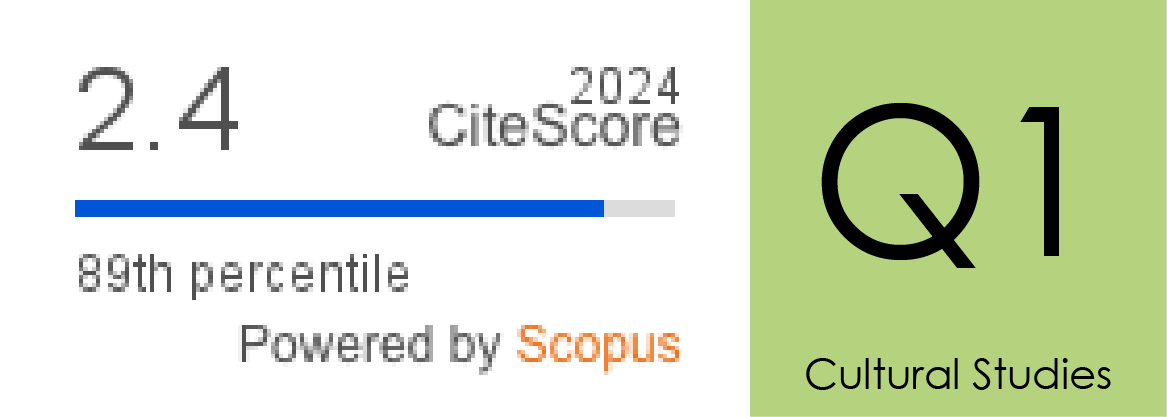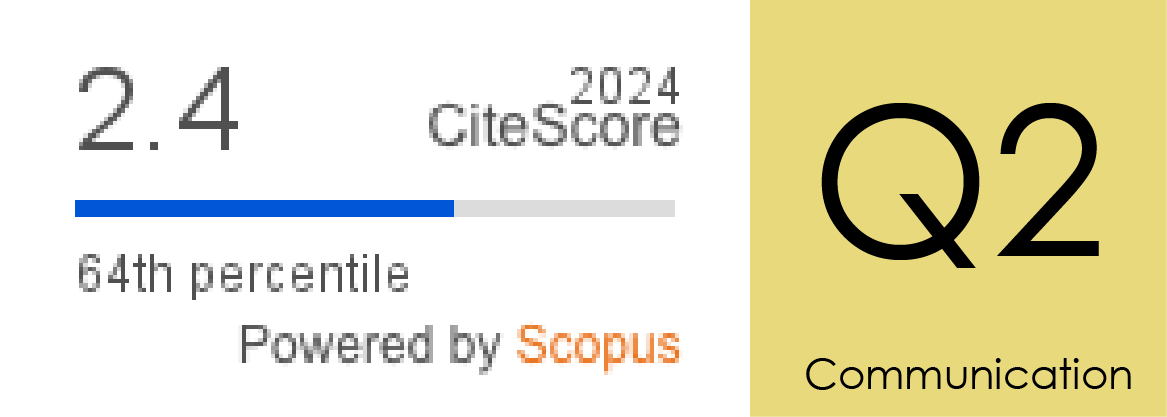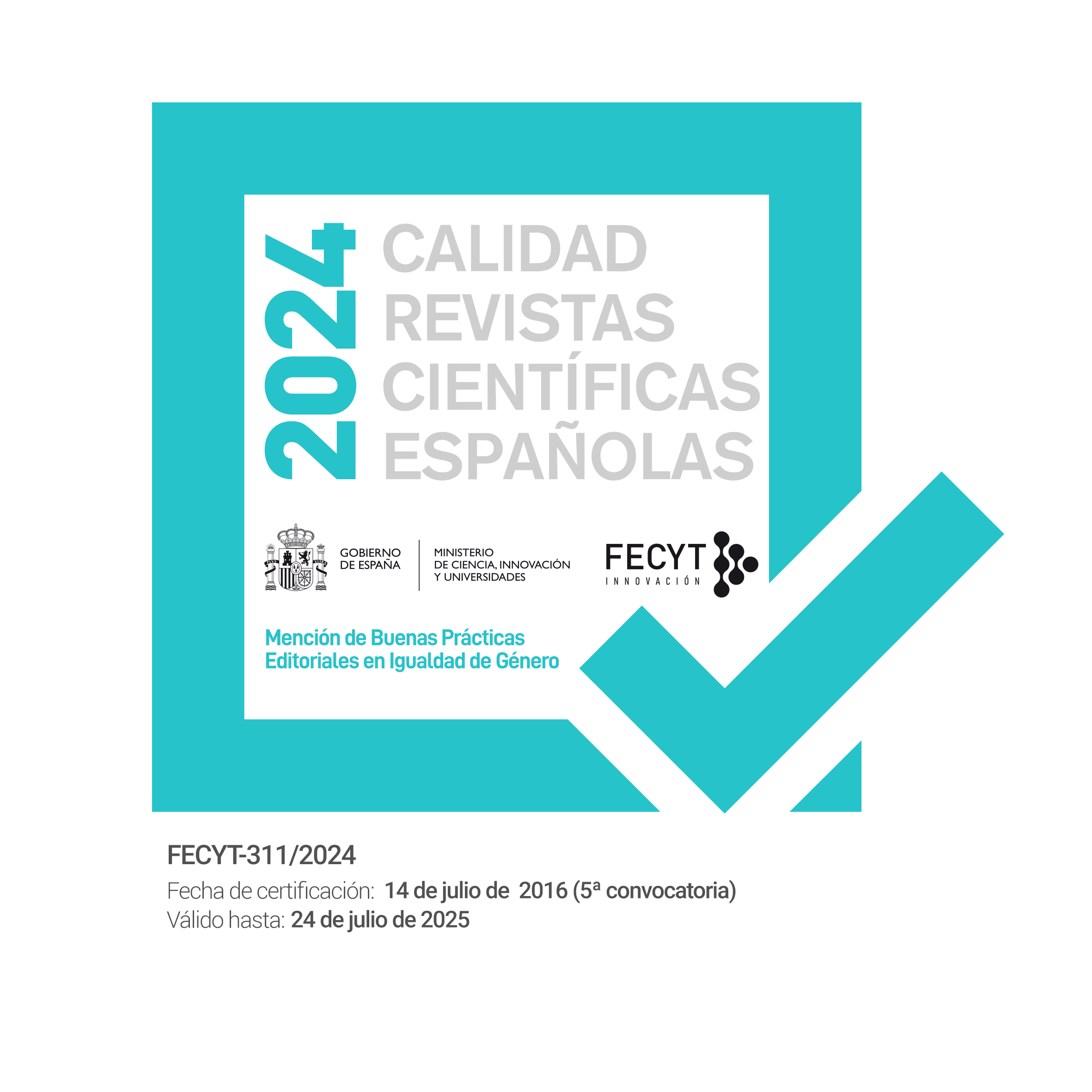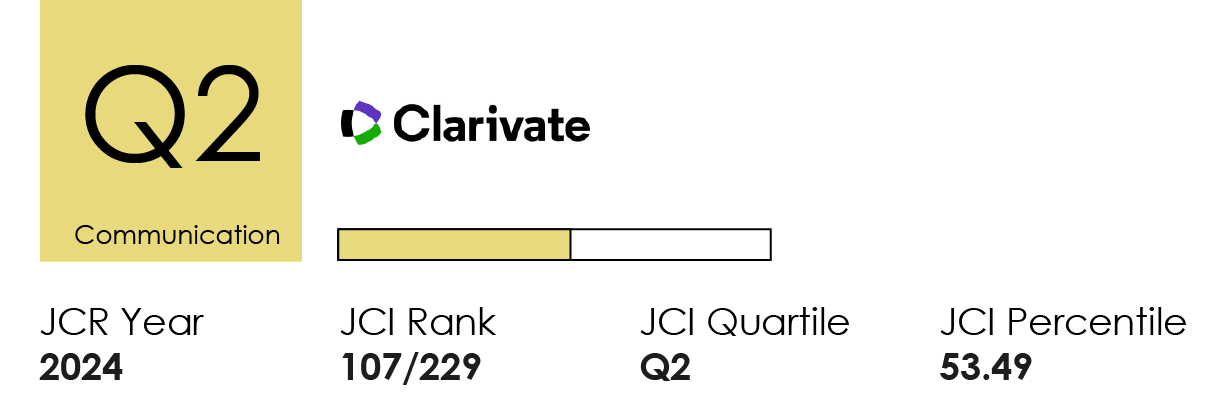El rol de la ciudadanía en la conversación política en X. El caso de la #MocionDeCensura de 2023 en España
DOI:
https://doi.org/10.14198/MEDCOM.26829Palabras clave:
Comunicación política, Democracia, Moción de censura, Medios digitales, Conversación política ciudadana, XResumen
El entorno digital se ha convertido es un espacio de conversación desde el que la ciudadanía puede generar y promover el debate en torno a cuestiones de gran relevancia política, dando voz a un colectivo anteriormente silenciado. El objetivo de esta investigación es analizar las dinámicas de participación ciudadana en el entorno digital sobre la Moción de Censura impulsada por Vox celebrada los días 21 y 22 de marzo de 2023. Para ello, se analizan los mensajes publicados en X por los usuarios que contenían el hashtag #MocionDeCensura (n=2000). Los resultados demuestran diversos apuntes interesantes. Primero, los ciudadanos fueron los usuarios que más mensajes compartieron durante la primera sesión. Segundo, el protagonismo está muy repartido entre Pedro Sánchez y Santiago Abascal, mientras que el candidato a presidente, Ramón Tamames tiene una presencia secundaria. Tercero, la función principal de los mensajes es la crítica, derivada especialmente de las intervenciones de los parlamentarios. Finalmente, en cuarto lugar, el clima de polarización existente en la sociedad se hace patente también en el debate generado en X, donde los comentarios muestran posiciones muy extremas, a favor o en contra de los políticos que intervinieron. Las tendencias detectadas confirman que X se ha convertido en un espacio de participación y deliberación donde los ciudadanos muestran su malestar y descontento acerca de la política.
Financiación
La investigación fue financiada por la Agencia Estatal de Investigación (MCIN/AEI/10.13039/501100011033/) y FEDER Una manera de hacer Europa, en la convocatoria de proyectos de I+D+i del año 2020, con código de referencia PID2020-119492GB-I00 y título de proyecto El rol de la ciudadanía en la comunicación política digital., Este artículo está vinculado a la Red de Investigación RED2022-134652-T, financiada por MCIN/AEI/10.13039/501100011033/ y “FEDER Una manera de hacer Europa”.Citas
Alonso-Muñoz, L., Miquel-Segarra, S., y Casero-Ripollés, A. (2016). Un potencial comunicativo desaprovechado. Twitter como mecanismo generador de diálogo en campaña electoral. Obra digital, 11, 39-58.
Barberá, P. (2020). Social media, echo chambers, and political polarization. En N.A. Persily, & J.A. Tucker (Eds.), Social media and democracy: The state of the field, prospects for reform (pp. 34-55). Cambridge University Press.
Bardin, L. (1996). Análisis de contenido. Akal.
Bastos, M. T., Mercea, D., & Charpentier, A. (2015). Tents, Tweets, and Events: The Interplay between Ongoing Protests and Social Media. Journal of Communication, 65(2), 320–50. https://doi.org/10.1111/jcom.12145
Bastos, M.T., & Mercea, D. (2019). The Brexit botnet and user-generated hyperpartisan news. Social science computer review, 37(1), 38-54. https://doi.org/10.1177/08944393177341
Bimber, B., Flanagin, A., & Stohl, C. (2012). Collective action in organizations: Interaction and engagement in an era of technological change. Cambridge University Press.
Borbath, E., Hutter, S., & Leininger, A. (2023). Cleavage politics, polarisation and participation in Western Europe. West European Politics, 46(4), 631-651. https://doi.org/10.1080/01402382.2022.2161786
Bruns, A., & Burgess, J.E. (2012). Researching news discussion on Twitter. Journalism Studies, 13(5-6), 801-814. https://doi.org/10.1080/1461670X.2012.664428
Bruns, A., & Highfield, T. (2013). Political networks on Twitter: Tweeting the Queensland state election. Information, Communication & Society, 16(5), 667-691. https://doi.org/10.1080/1369118X.2013.782328
Casas, A., y Williams, N.W. (2019). Images That Matter: Online Protests and the Mobilizing Role of Pictures. Political Research Quarterly, 72(2), 360–75. https://doi.org/10.1177/1065912918786
Casero-Ripollés, A. (2018). Research on political information and social media: Key points and challenges for the future. Profesional de la Información, 27(5), 965-975. https://doi.org/10.3145/epi.2018.sep.01
Casero-Ripollés, A. (2021). Influencing the public agenda in the social media era: Questioning the role of mainstream political journalism from the digital landscape. In J. Morrison, J. Birks y M. Berry (Eds.), The Routledge Companion to Political Journalism (pp. 322-329). Routledge.
Casero-Ripollés, A., Alonso-Muñoz, L., & Marcos-García, S. (2022). The Influence of Political Actors in the Digital Public Debate on Twitter About the Negotiations for the Formation of the Government in Spain. American Behavioral Scientist, 66(3), 307-322. https://doi.org/10.1177/00027642211003159
Casero-Ripollés, A., Micó-Sanz, J. L., & Díez-Bosch, M. (2020). Digital public sphere and geography: The influence of physical location on Twitter’s political conversation. Media and Communication, 8(4), 96-106. http://dx.doi.org/10.17645/mac.v8i4.3145
Casero-Ripollés, A., & Ribeiro, V. (2023). Blurring boundaries in political journalism? The digital authority of citizens in the public debate on Twitter. In M-C. Negreira-Rey, J. Vázquez-Herrero, J. Sixto-García y X. López-García (Eds), Blurring Boundaries of Journalism in Digital Media: New Actors, Models and Practices (pp. 121-133). Springer International Publishing.
Castells, M. (2013). Communication power. Oxford University Press.
Chadwick, A. (2017). The hybrid media system: Politics and power. Oxford University Press.
Centro de Investigaciones Sociológicas [CIS]. (2022). Encuesta sobre cuestiones de actualidad. Estudio nº 3362. https://acortar.link/MWGl0R
Coleman, S. (2005). New mediation and direct representation: reconceptualizing representation in the digital age. New Media & Society, 7(2), 177-198. https://doi.org/10.1177/1461444805050745
Colleoni, E., Rozza, A., & Arvidsson, A. (2014). Echo chamber or public sphere? Predicting political orientation and measuring political homophily in Twitter using big data. Journal of Communication, 64(2), 317-332. https://doi.org/10.1111/jcom.12084
Dryzek, J. S. (2000). Discursive democracy vs. liberal constitutionalism. In M. Saward (Ed), Democratic innovation: deliberation, representation, and association (pp. 78-89). Routledge.
Durántez-Stolle, P., Martínez-Sanz, R., Piñeiro-Otero, T., & Gómez-García, S. (2023). Feminism as a polarizing axis of the political conversation on Twitter: the case of #IreneMonteroDimision. Profesional de la información, 32(6), e320607. https://doi.org/10.3145/epi.2023.nov.07
Enli, G., & Skogerbø, E. (2013). Personalized campaigns in party-centred politics: Twitter and Facebook as arenas for political communication. Information, Communication & Society, 16(5), 757-774. https://doi.org/10.1080/1369118X.2013.782330
Feenstra, R.A., Tormey, S., Casero-Ripollés, A., & Keane, J. (2017). Refiguring democracy: The Spanish political laboratory. Routledge.
García-Escribano, J. J., García-Palma, M-B., y Manzanera-Román, S. (2021). La polarización de la ciudadanía ante temas posicionales de la política española. Revista más poder local, 45, 57-73.
Gidron, N., Adams, J., & Horne, W. (2020). American affective polarization in comparative perspective. Cambridge University Press.
Gruzd, A., & Wellman, B. (2014). Networked Influence in Social Media: Introduction to the Special Issue. American Behavioral Scientist, 58(10), 1251-1259. https://doi.org/10.1177/0002764214527087
Guo, J., & Liu, S. (2022). From #BlackLivesMatter to #StopAsianHate: Examining network agenda-setting effects of hashtag activism on Twitter. Social Media+ Society, 8(4). https://doi.org/10.1177/20563051221146182
Gutiérrez-Rubí, A. (2011). La política vigilada: la comunicación política en la era de Wikileaks. UOC.
Habermas, J. (2006). Political communication in media society: Does democracy still enjoy an epistemic dimension? The impact of normative theory on empirical research. Communication Theory, 16(4), 411-426. https://doi.org/10.1111/j.14682885.2006.00280.x
Hanna, A., Wells, C., Maurer, P., Friedland, L., Shah, D., & Matthes, J. (2013). Partisan alignments and political polarization online: A computational approach to understanding the French and US presidential elections. In I. Weber, A-M. Popescu y M. Pennacchiotti (Eds.), Proceedings of the 2nd workshop politics, elections and data (pp. 15-21). ACM.
Hepp, A. (2019). Deep Mediatization. Routledge.
Hermida, A. (2012). Tweets and truth: Journalism as a discipline of collaborative verification. Journalism Practice, 6(5-6), 659-668. https://doi.org/10.1080/17512786.2012.6 67269
Hjarvard, S. (2013). The Mediatization of Culture and Society. Routledge.
Igartua, J.J., y Humanes, M. L. (2004). Teoría e investigación en comunicación social. Síntesis.
Jamieson, K.H., & Cappella, J.N. (2008). Echo chamber: Rush Limbaugh and the conservative media establishment. Oxford University Press.
Jenkins, H. (2006). Convergence culture: Where old and new media collide. University Press.
Jungherr, A. (2014). Twitter in politics: a comprehensive literature review. SSRN 2402443.
Jungherr, A., & Jürgens, P. (2014). Through a glass, darkly: tactical support and symbolic association in Twitter messages commenting on Stuttgart 21. Social Science Computer Review, 32(1), 74–89. https://doi.org/10.1177/0894439313500022
Jungherr, A., Rivero, G., & Gayo-Avello, D. (2020). Retooling Politics: How Digital Media Are Shaping Democracy. Cambridge University Press.
Jungherr, A., Jürgens, P., & Schoen, H. (2012). Why the pirate party won the german election of 2009 or the trouble with predictions: a response to Tumasjan, A., Sprenger, T. O., Sander, P. G., & Welpe, I. M. “predicting elections with Twitter: what 140 characters reveal about political sentiment”. Social Sciences Computer Review, 30, 229–234.
Krukemeier, S. (2014). How political candidates use Twitter and the impact on votes. Computers in Human Behavior, 34, 131-139. http://dx.doi.org/10.1016/j.chb.2014.01.025
Larsson, A.O. (2015). Comparing to prepare: Suggesting ways to study social media today—and tomorrow. Social Media+ Society, 1(1). https://doi.org/10.1177/2056305115578680
Lin, Y.R., Margolin, D., Keegan, B., Baronchelli, A., & Lazer, D. (2013). #Bigbirds never die: Understanding social dynamics of emergent hashtags. In Proceedings of the International AAAI Conference on Web and Social Media, 7(1), 370-379.
López-Meri, A. (2015). Twitter como fuente informativa de sucesos imprevistos: el seguimiento de hashtags en el caso #ArdeValencia. Anuario Electrónico de Estudios en Comunicación Social “Disertaciones", 8(1), 27-51. http://dx.doi.org/10.12804/disertaciones.01.2015.02
Marcos-García, S., Alonso-Muñoz, L., y López-Meri, A. (2021). Campañas electorales y Twitter. La difusión de contenidos mediáticos en el entorno digital. Cuadernos. info, 48, 27-47. http://dx.doi.org/10.7764/cdi.48.1738
Marcos-García, S., Alonso-Muñoz, L., y Casero-Ripollés, A. (2017). Usos ciudadanos de Twitter en eventos políticos relevantes. La #SesiónDeInvestidura de Pedro Sánchez. Comunicación y hombre, 13, 25-49.
Mazzoleni, G. (2010). La comunicación política. Alianza.
Orriols, L., & Cordero, G. (2016). The breakdown of the Spanish two-party system: the upsurge of Podemos and Ciudadanos in the 2015 general election. South European Society and Politics, 21(4), 469-492. https://doi.org/10.1080/13608746.2016.1198454
Pariser, E. (2011). The filter bubble: What the Internet is hiding from you. Penguin
Ramírez-Dueñas, J. M., & Vinuesa-Tejero, M. L. (2021). How does selective exposure affect partisan polarisation? Media consumption on electoral campaigns. The Journal of International Communication, 27(2), 258-282. https://doi.org/10.1080/13216597.2021.1899957
Sánchez-Meza, M., Schlesier-Corrales, L., Visa-Barbosa, M., y Carnicé-Mur, M. (2023). ¿De redes sociales a redes del odio? Análisis de la conversación digital en Twitter sobre la ministra de Igualdad española Irene Montero. Estudios sobre el Mensaje Periodístico, 29(3), 717-736. https://dx.doi.org/10.5209/esmp.87271
Scammell, M. (2000). The internet and civic engagement: The age of the citizen-consumer. Political Communication, 17(4), 351-355. https://doi.org/10.1080/10584600050178951
Shirky, C. (2011). The political power of social media: Technology, the public sphere, and political change. Foreign affairs, 28-41.
Strömbäck, J., & Esser, F. (2014). Mediatization of Politics: Towards a Theoretical Framework. In F. Esser y J. Strömbäck (Eds.), Mediatization of Politics. Understanding the Transformation of Western Democracies (pp. 3-28). Palgrave Macmillan.
Sunstein, C.R. (2018). #Republic. Divided Democracy in the Age of Social Media. Princeton University Press.
Tufekci, Z., & Wilson, C. (2012). Social media and the decision to participate in political protest: Observations from Tahrir Square. Journal of Communication, 62(2), 363-379. https://doi.org/10.1111/j.1460-2466.2012.01629.x
Van Dijck, J. (2013). The culture of connectivity: A critical history of social media. Oxford University Press.
Verba, S., & Nie, N.H. (1972). Participation in America: Political Democracy and Social Equality. University of Chicago Press.
Wright, S., & Street, J. (2007). Democracy, deliberation and design: the case of online discussion forums. New Media & Society, 9(5), 849-869. https://doi.org/10.1177/1461444807081230
Wolton, D. (1990). Political communication: the construction of a model. European Journal of Communication, 5(1), 9-28. https://doi.org/10.1177/0267323190005001002
Zaller, J.R. (1992). The nature and origins of mass opinion. Cambridge University Press.
Zappavigna, M. (2015). Searchable talk: The linguistic functions of hashtags. Social semiotics, 25(3), 274-291. https://doi.org/10.1080/10350330.2014.996948
Zulli, D. (2020). Evaluating hashtag activism: Examining the theoretical challenges and opportunities of #BlackLivesMatter. Participations, 17(1), 197-215.
Descargas
Estadísticas
Publicado
Cómo citar
Número
Sección
Licencia
Derechos de autor 2024 Laura Alonso-Muñoz, Andreu Casero-Ripollés

Esta obra está bajo una licencia internacional Creative Commons Atribución 4.0.
Los autores y autoras que publican en esta revista están de acuerdo con los siguientes términos:
1 Derechos de autor. Los autores y autoras conservan sus derechos de autor, aunque ceden a la revista de forma no exclusiva los derechos de explotación (reproducción, distribución, comunicación pública y transformación) y garantizan a esta el derecho de primera publicación de su trabajo, el cual estará simultáneamente sujeto a la licencia indicada en punto 2. Los autores pueden establecer otros acuerdos adicionales para la distribución no exclusiva de la versión de la obra publicada en la revista, siempre que exista un reconocimiento de su publicación inicial en esta revista.
© Los autores.
2 Licencia. Los trabajos se publican en la revista sujetos a la licencia de Reconocimiento 4.0 Internacional de Creative Commons (CC BY 4.0); los términos se pueden consultar en https://creativecommons.org/licenses/by/4.0/
Esta licencia permite a terceros compartir (copiar y redistribuir el material en cualquier medio o formato) y adaptar (remezclar, transformar y crear a partir del material para cualquier finalidad, incluso comercial), siempre que se reconozca la autoría y la primera publicación en esta revista (Revista Mediterránea de Comunicación (RMC) / Mediterranean Journal of Communication (MJC), Universidad de Alicante, DOI de la obra), se proporcione un enlace a la licencia y se indique si se han realizado cambios en la obra.
3 Política de autoarchivo. Se recomienda a los autores que difundan sus trabajos a través de Internet para favorecer una circulación y difusión más rápidas y, con ello, un posible aumento en la citación y alcance entre la comunidad científica y académica, en las siguientes condiciones:
No se permite a los autores depositar en un repositorio institucional o temático, página web propia, etc., las versiones preprint (versión antes de ser evaluada) o postprint (versión evaluada y aceptada para su publicación) de sus trabajos antes de su publicación, pero sí el artículo final publicado (versión del editor).













